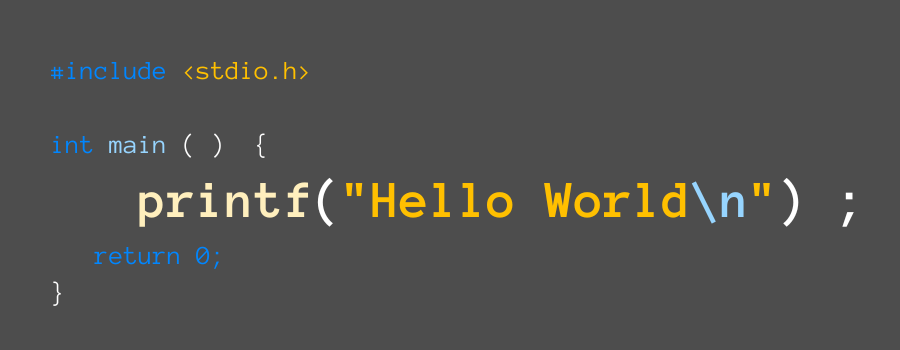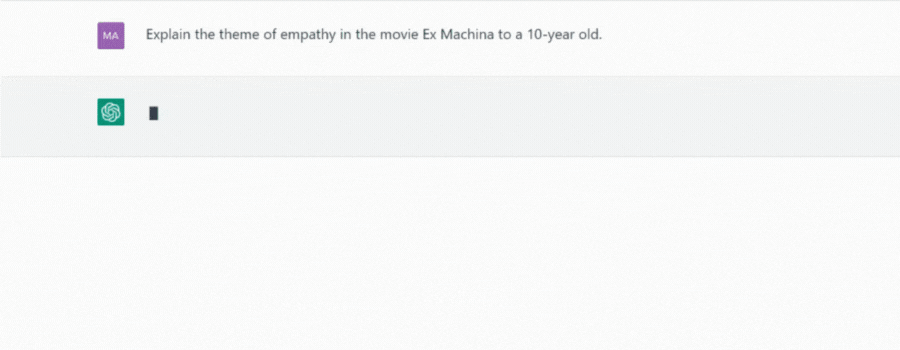

“Hello, World” to ChatGPT: The Evolution of AI in Writing
Anyone who knows basic programming is well aware of “hello, world.” First appearing in the 1970s, this iconic little prompt results from the first program that most coders will ever write: seeing these two tiny words appear on the screen means that you have successfully worked in tandem with your computer, creating something–however small–together. It tells you that you two understand each other and that you speak the same language.
About thirty years after “hello, world” hit the scene, in the still-early days of chatbots, graduate student Jay Caspian Kang tried to get an AI to help him write his fiction assignments. The aspiring young author “dreamed of a technology that would tell me how to get my characters from point A to point B.” Sadly, as he explains in a recent piece in The New Yorker, “Could an A.I. Chatbot Rewrite My Novel?”, the only tool available in the early 2000s was ”a Web site called the Postmodern Generator that spat out nonsensical but hilarious critical-theory papers.”

Enter ChatGPT, the biggest mainstream AI moment
It would be two more decades before Kang—or any of us early-day “hello, world” tech dreamers—would get our wish. Enter the bot ChatGPT (Chat Generative Pre-trained Transformer) released onto the market by San Francisco company OpenAI in early December 2022. Quickly named the fastest-growing consumer application in history, ChatGPT adoption blew past any other consumer tech (including preexisting AI writing tools) and is estimated to have reached 100 million monthly active users in January, just two months after launch.
On the surface, it seems to write oddly human-like prose that has caused authors, marketing content creators, and educators alike to wonder whether we are finally at the dawn of the “Robot Writing Revolution.” So, is it true, what everyone is so afraid (or in awe) of? Can the new class of AI really write better than we humans can?
ChatGPT: Friend or Foe? How AI is Changing the Landscape of Creativity and Education
The short answer is still “no.” Upon asking ChatGPT to essentially rewrite a novel he’s already published, Kang was less than excited with the results: “I tried for the better part of an hour,” he laments, after attempting to get the AI to create a new iteration of his published book’s narrative. “But the closest it came to anything useful was when it told me that some of the secondary characters in the novel could be ‘Emma, Liam, Olivia, or Ethan.’”
Kang is not alone in his findings. Despite fear talk and countless TikTok videos displaying ChatGPT-created copy that supposedly rivals anything Shakespeare wrote—the new bots are not all that original or particularly interesting. Nor are they a suitable replacement for marketing and advertising creatives—so you don’t need to worry about your job quite yet.
“The fact is that throughout history, we’ve seen that new developments in technology have tended to create new jobs as quickly as it makes old jobs redundant,” says Bernard Marr, in his Forbes article on the subject, How Will ChatGPT Affect Your Job if You Work in Advertising and Marketing? “What’s more, the jobs that are created are often more technical, creative, or highly skilled–meaning that they are higher paying and often more rewarding.”
Educators may have the most cause for concern, though: the AI is able to competently write essays at a high school or even college level. Professors across the country are “starting to overhaul classrooms in response to ChatGPT, prompting a potentially huge shift in learning and teaching,” reports Kalley Huang for the New York Times. AI detection tools and cryptographic watermarks are beginning to appear, and anti-plagiarism programs like GPTZero are already in use by the Ivy League.

Enhancing Content Creation: How ChatGPT Can Benefit Marketers
So how do we, in marketing, embrace this “brave new world” into our everyday work?
First, we should refuse to see programs like ChatGPT as our enemies. On the contrary, we have to view these new AI services as our partners—a cool, useful new tool in our tech arsenals, suited to handling some of our basic work, freeing our creative brains to do what they do best. “As we have learned from previous eras of accelerated technology-driven change—such as the industrial revolution or the computer age—those who prosper will be those who learn to work alongside the technology,” writes Marr.
But what does that mean day to day? What does this new partnership look like in the world of modern marketing?
Understanding the Limits and Potential of AI in Marketing
Even though artificial intelligence is the current buzzword in the world of marketing, it will not solve every challenge. The biggest drawback of AI-created content is simple inaccuracy. It also lacks the fundamental human attributes to create emotionally intelligent output.
AI will not:
- Make strategic, high-level decisions involving multiple consideration points
- Connect authentically with audiences in meaningful ways
- Have a unique voice, perspective, and consistency in all content creation
- Display strong emotional intelligence and empathy
However, AI will:
- Quickly synthesize texts from multiple sources and analyze large amounts of data
- Supplement the editorial process, from ideation to editing
- Use natural language processing algorithms to generate content
- Provide predictive analytics to forecast future trends and behaviors
Regardless of the AI tool you try, your own experimentation and analysis are key. AI moves fast. The limitations of a solution you try today may vanish in weeks. Gaining a deeper understanding of the opportunities presented by ChatGPT and others is already helping marketers accelerate testing new concepts and messaging, and helping to become even more creative and innovative.
BONUS: See the power of compelling content in the case study on “Smart Cities Stories”
The Future of AI in Creative Content and Marketing: Embracing Our New Partner
Our experience with technology has evolved fantastically since the first “hello, world” output appeared in computing decades ago. Instead of two simple words, we now have AI processing vast amounts of human-generated texts on the Internet and transforming them in new, innovative ways. Optimism and open-mindedness will help us capitalize on this newest, and potentially most consequential paradigm shift we’re likely to witness.
At Bridge Partners, we are excited about the opportunities this new generation of AI presents. Our deeply experienced people will always bring the best ideas to the table. AI, alongside our entire marketing tech stack, is already helping us quickly test new messaging and new approaches. It is beginning to free us from the simpler tasks better suited to automation, so we can dedicate more energy to helping our clients grow their businesses.
“Tools like ChatGPT aren’t going anywhere; they’re only going to improve, and barring some major regulatory intervention, this particular form of machine intelligence is now a fixture of our society,” says Kalley Huang. Our fancy machine friends are here to stay, and they’re getting smarter fast.
Revolutionary new tools and inventions, when properly wielded, can change the game.
“Hello, friend.” We’re so glad you’re here.
MODERN STORYTELLING DONE RIGHT
Bridge Partners creates powerful and productive customer engagement with modern storytelling techniques and data-informed messaging, delivering real results for the world’s largest tech and cloud companies.
Learn more about what it’s like to work at Bridge Partners at our Careers page and follow us on LinkedIn for the latest company news.
This article was co-written by Matt Hansink, Jen Calvin, and Marisa Lather.
About the author




